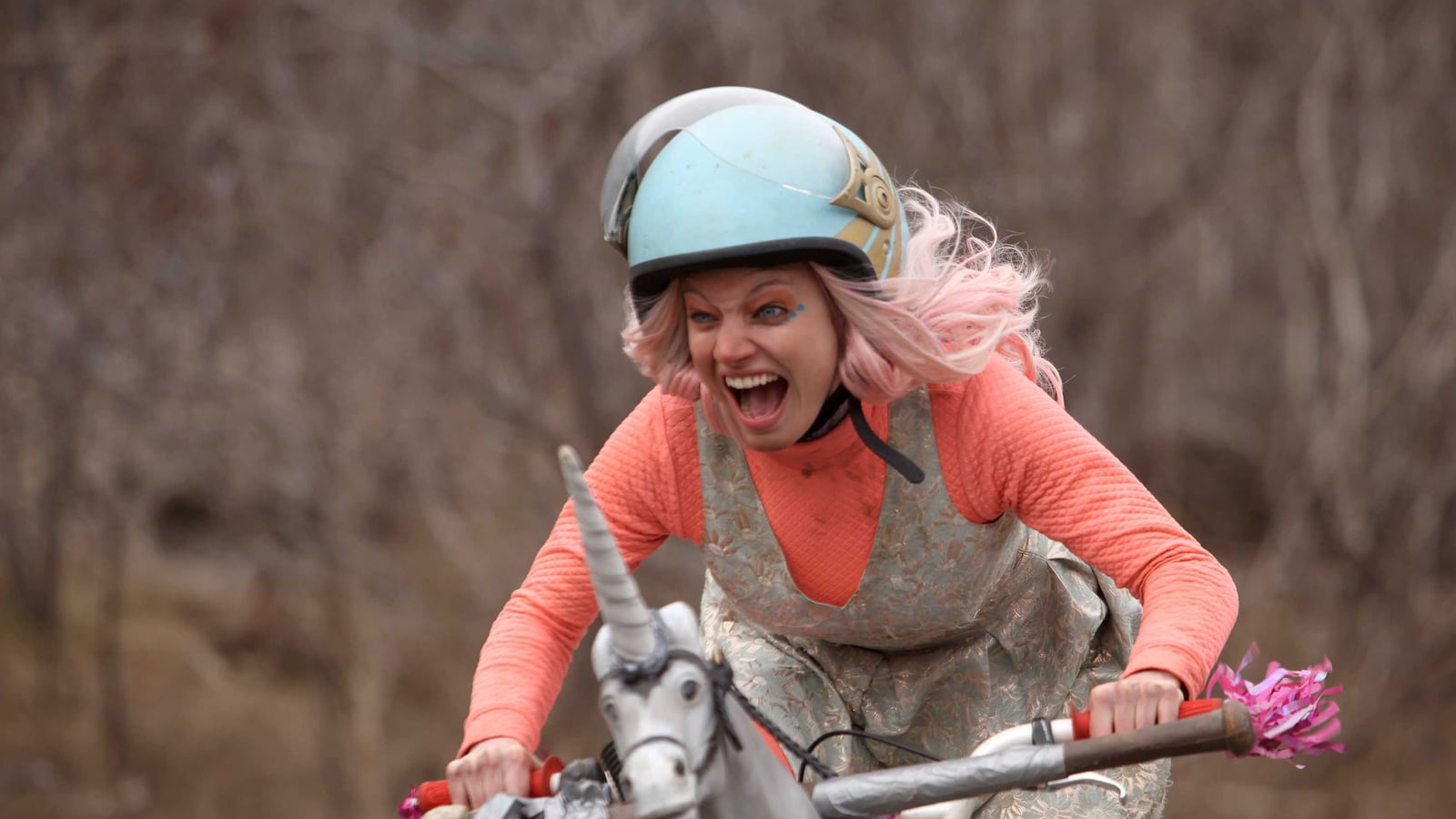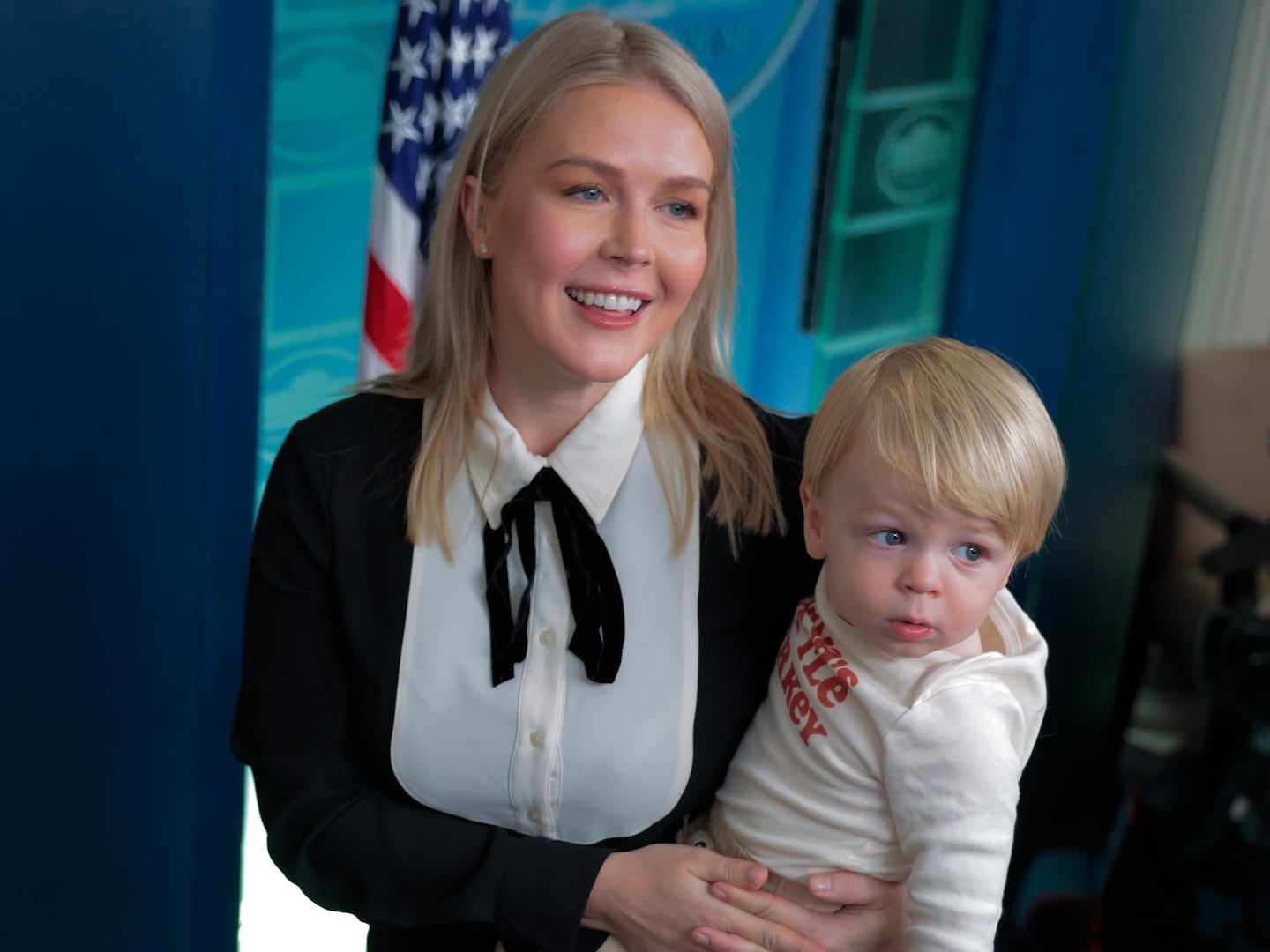In the bleak and barren future…. the year 1997… nuclear apocalypse has rendered the world ruined and nearly uninhabitable. Roving bands of murderous goons troll the wilderness killing for drops of precious water. Into this desolate landscape, with a pulsing ’80s-synth score behind him, wheels a hero in the making—the hero the post-apocalypse needs.
Forget Mad Max. Meet The Kid, the teenage road warrior with no name who dirt-bikes his way through the Wasteland armed with a turbocharged blaster in the blood-splattered Sundance breakout hit Turbo Kid.
“It is a love letter to our childhood,” explains Yoann-Karl Whissell, a gregarious and bespectacled Montreal native who, with Anouk Whissell and Francois Simard, comprises Turbo Kid’s directing collective RKSS (aka RoadKill Superstar Films). “It’s The Goonies. It’s The NeverEnding Story. Kids getting together and finding first love…”
…and battling sadistic one-eyed warlords and buzzsaw-wielding psychogoons, exploding heads into bloody bursts in the process. While contending with robots. And BMX bandits. And that supercharged ’80s throwback synth score, courtesy of French-Canadian electro duo Le Matos (one-half of which, Jean-Phillippe Bernier, also happens to be Turbo Kid’s cinematographer).
It’s a late summer day in downtown Los Angeles when I catch up with the two Whissell siblings and Simard, who’ve arrived in town for the final festival stop on their whirlwind Turbo Kid tour. Theirs is a journey that kicked off seven months ago in Park City, Utah, where the world premiere of the bloody sci-fi midnight movie crowd-pleaser landed the tight-knit trio on Hollywood’s radar and earned them raving kudos from critics.
Since their “surreal” Sundance debut, RKSS signed with their first agents (“Most agents said, ‘You’ll make a lot of money.’ Ours said, ‘What do you want to do?’”). They won the Audience Award at SXSW. Just before bringing Turbo Kid to a receptive crowd of LA hipsters at Sundance’s Next Fest, RKSS premiered their feature debut to the audience that mattered most—in their hometown of Montreal at Fantasia Fest, where an emotional screening began with a theater full of meowing cat sounds (a Fantasia tradition) and ended with all of RKSS in tears.
In the same summer that saw George Miller’s $150 million-budgeted third Mad Max melt the faces off of mainstream audiences across the globe, Turbo Kid gives fans of post-apocalyptic cinema yet another Mad Max-esque action romp to champion—one made for a fraction of Fury Road’s budget during the coldest spring to hit North America in decades.
Like the Italian Mad Max/Road Warrior exploitation knockoffs of the ’80s that inspired the VHS-generation RKSS directors—think 1990: The Bronx Warriors, Exterminators of the Year 3000, The New Barbarians—Turbo Kid embraces familiar post-apocalyptic tropes, along with teen cult classics of that decade.
“There’s a little bit of John Hughes, definitely some early Peter Jackson,” says Yoann-Karl Whissell, citing Braindead (aka Dead Alive) as the movie that made him want to make movies, as well as Sam Raimi’s Evil Dead, Tarantino, and the cult Canuxploitation movie The Dog That Stopped The War—“a classic… in Quebec.”
Its hero is a loner, the orphaned Kid (Degrassi’s Munro Chambers) who scavenges the Wasteland for valuables to barter for even more valuable H20. There’s a nefarious villain, Zeus (Scanners, Total Recall, and Starship Troopers genre icon Michael Ironside) who rules the land with an army of bloodthirsty, tricked out bikers—that’s BMX bikers—and a plot that sends the reluctant Kid careening along his hero’s journey when he stumbles across a weapon straight out of his favorite comic book.
Fury Road has an Imperator Furiosa to blaze and blast her way through the desolate Wasteland; Turbo Kid has Apple. Played by Quebecois actress Laurence Leboeuf with the relentless glee of a My Little Pony come to life, the pink-haired manic pixie Wasteland girl gives Turbo Kid the kind of infectiously appealing sidekick/love interest that would’ve driven Max Rockatansky into the salt flats.
She’s also the reason why, between spurts of crowd-pleasing practical FX gore, Turbo Kid’s got a sweeter core than any of its forebears. Take it from the director of retro splatterfest Hobo With a Shotgun, Jason Eisener, who executive produced the Canadian-New Zealand co-production: “With a movie like this, heart is the most important aspect. I always trusted that even with a low budget action movie in a post apocalyptic world, RKSS would bring the heart and it would ring true through the whole film.”
The timing, fittingly, brings the low-budget Turbo Kid full circle with its Mad Max roots. The film started out as a short called T is for Turbo, created for $4,000 as part of a filmmaking contest competing for a slot in Ant Timpson’s ABCs of Death horror anthology. The short won the popular audience vote but didn’t make it into the film. Still, RKSS won a pretty solid consolation prize: Timpson came calling, asking if they wanted to expand T is for Turbo into a feature film.
With Timpson producing and Eisener onboard as executive producer, the writer-directors wrote a feature script in three weeks and took it to the burgeoning Frontieres Film Market during Fantasia Fest, the hometown film fest that the directors had attended since their teens, as fans. There, they energetically pitched Turbo Kid’s full costumes on BMX bikes to a room full of potential financiers. One of them bit.
“This was a leap of faith,” recalls Anne-Marie Gélinas, the producer who came aboard and helped land Turbo Kid’s first round of financing. “It’s homage, not a farce, but the line between the two is super thin.” The Turbo Kid gang landed their biggest name star when Gélinas marched her directors up to Ironside, who they’d written the part for, and pitched him on the spot during a chance meeting at a Toronto Film Festival cocktail hour.
Taken by “this crazy script,” American shingle Epic Pictures filled in the rest of the budget at the 11th hour and filming was underway in a matter of days. And after writing and directing over 20 short films, the filmmakers finally quit their day jobs.
“It was the best feeling,” grins Yoann-Karl.
On set, it was Yoann-Karl who handled much of the cast direction while Francois manned the monitors, keeping close watch on the storyboards he and Anouk, who met in animation school, created ahead of filming. Anouk, Yoann-Karl’s soft-spoken sister, ran the ship, coordinating the directing team through each shot. “Michael Ironside called her The Boss on set,” her brother beams.
The shoot was gnarly, in a harsh and unseasonable cold that dipped to -20 degrees Celsius and froze the production’s copious supplies of fake blood right in their pipes. Like most filmmakers, RKSS laments the shots they didn’t have time or money to pull off.
“We had to leave out a gore moment taken from T is for Turbo,” says Simard with a wistful grin. “If you watch the short, it’s when I start puking and get my head chopped off, so you have the blood and vomit flying everywhere—”
“—so it’s going to be in the sequel,” adds Yoann-Karl, confirming that he has indeed already started writing a sequel. “Spoilers!”
The three speak reverently of George Miller and his Mad Max quadrilogy, which they caught in theaters in the middle of the Turbo Kid tour. “What’s fantastic is that George Miller directs like a 25-year-old,” says Yoann-Karl. “I love that he went into a meeting saying, ‘I want a guy that is blind strapped to a vehicle made of amp speakers with a guitar—but the guitar is also a flamethrower’—and everybody went, ‘Yeah, sure! No problem!’”
“It’s what movies should be,” he marvels. “Complete freedom. He just went for it, and that’s why it works. The Doof Warrior is cinema.”
The “for genre nerds, by genre nerds” mentality of embracing DIY limitations and expansive B-movie pastiche only lends Turbo Kid a charm that bigger, more cynical movies could never pull off. RKSS’s geek cred has earned them a spot within a growing genre film subculture that gathers at festivals like Sundance and Toronto, Austin’s Fantastic Fest, Sitges in Spain, and Fantasia, where loyal cult cinema devotees can appreciate the lovingly retro aesthetic.
“Those movies remind me of when I was a kid playing in my sandbox grabbing Ninja Turtles, GI Joes, and BraveStarr action figures, creating battle scenes in sand castles with all these different characters mashed together,” says Eisener. “Punks and metalheads and futuristic robots—it’s this whole mishmash, as if you dumped out a kid’s toy box and made a movie with it.”






